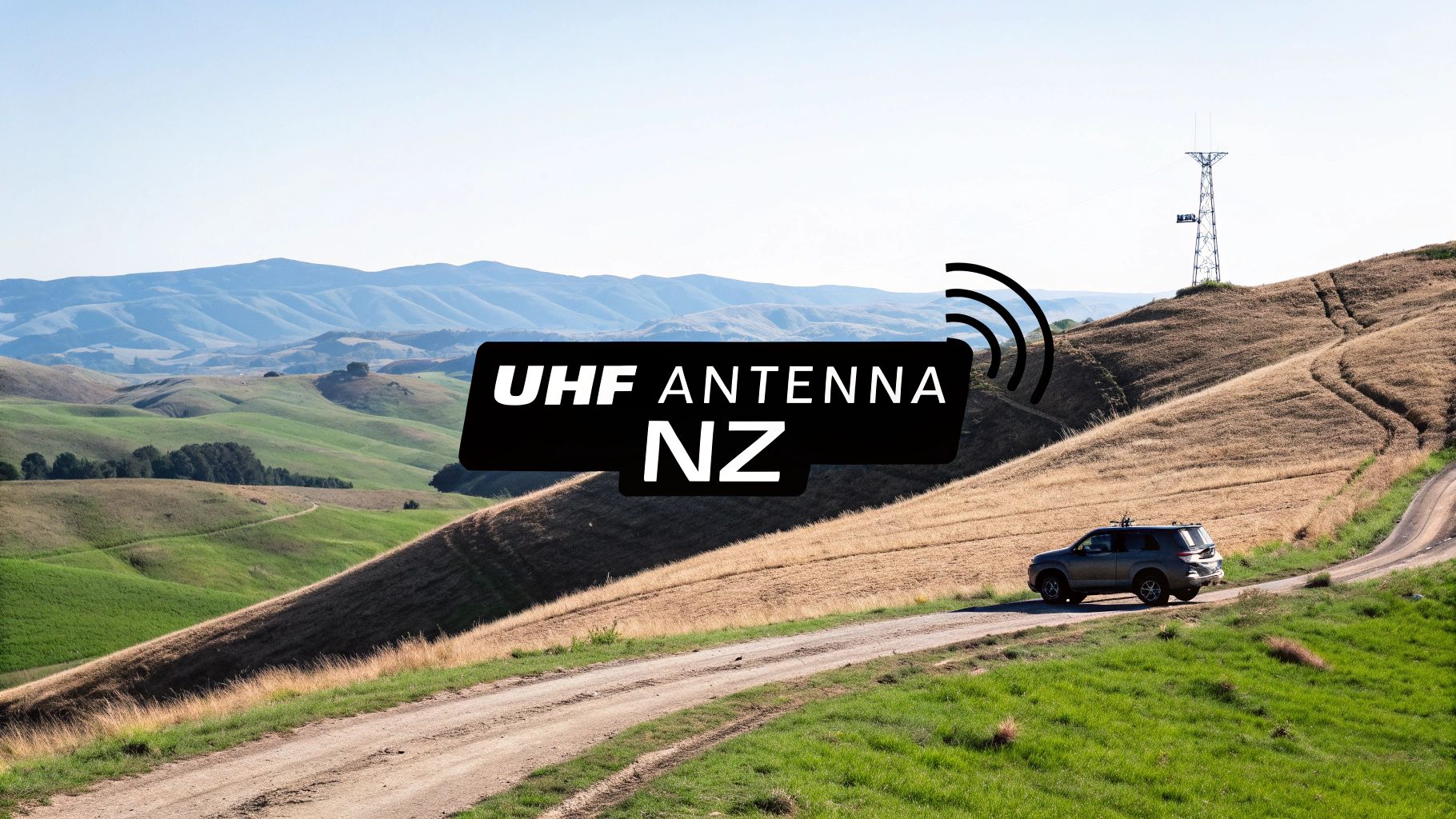A Guide to VHF Radio Channels NZ
Trying to get your head around the different VHF radio channels in New Zealand can feel a bit daunting at first. But it all comes down to two main groups of legal communication solutions: maritime channels for everything happening out on the water, and land-based channels for commercial or private use back on shore. Knowing which frequency to be on isn't just good practice—it's a legal and safety must-have for clear, reliable communication with devices commonly available in New Zealand.
Your Guide to NZ VHF Radio Channel Allocations
This guide is designed to be your go-to reference for all the legal VHF radio channels we use here in New Zealand. We'll walk through the crucial maritime channels used for distress calls, chatting with port authorities, and getting the latest weather updates. We'll also cover the land-based Personal Radio Service (PRS) and CB frequencies that are the backbone of communication for industries like farming and forestry, as well as for recreational users, all using legally compliant radio equipment.
Using the right channel is about more than just following the rules; it prevents you from accidentally talking over someone else’s critical conversation and makes sure your own messages get through loud and clear.
The image below gives a great snapshot of the VHF channel landscape in New Zealand.
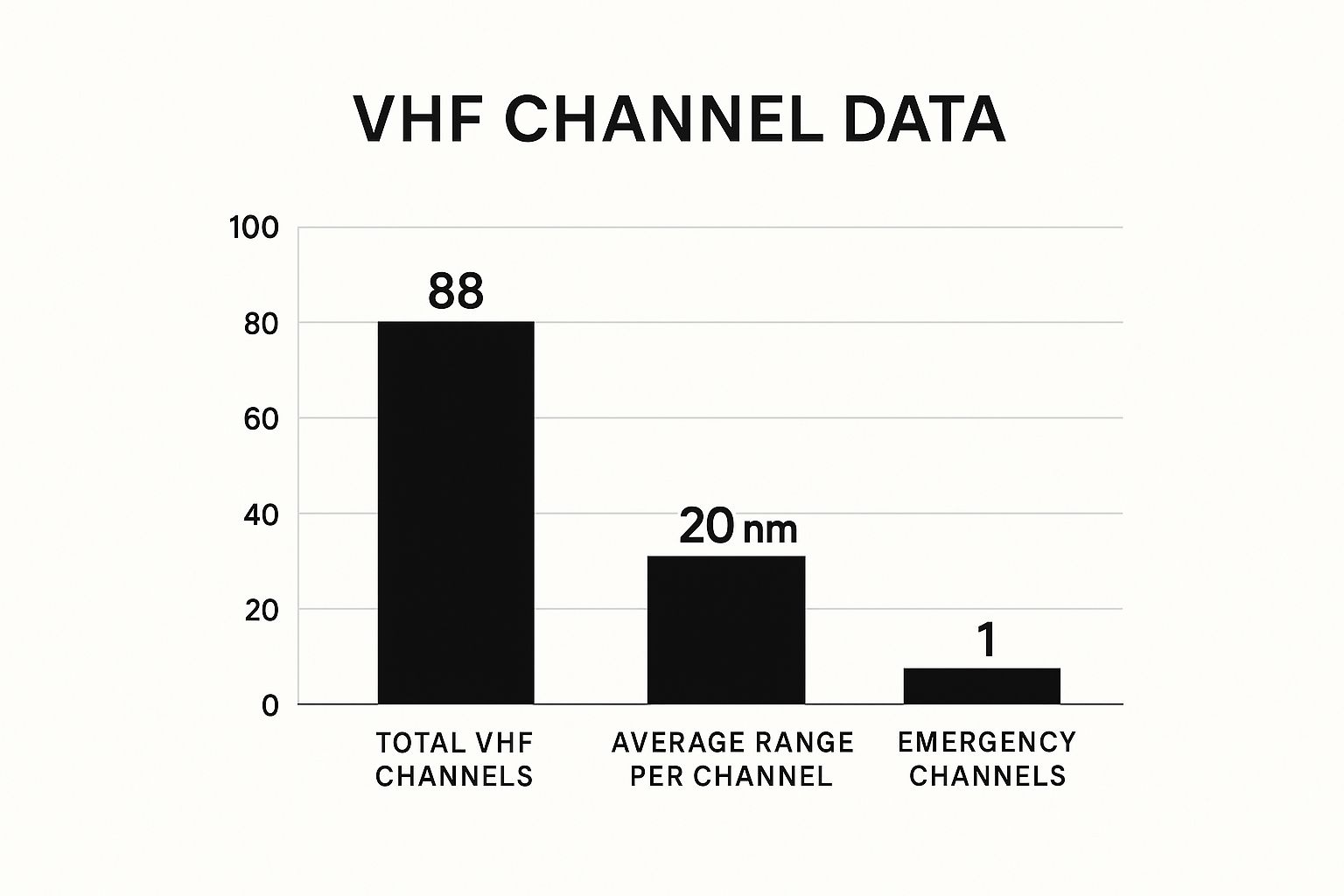
What really stands out is that even with 88 channels available, there’s only one single channel dedicated to emergencies. It’s a stark reminder of just how important it is to keep that channel clear and reserved for its one, vital purpose.
Quick Reference NZ VHF Channel Uses
For a quick overview, this table breaks down the most common VHF channel uses across New Zealand. It's a handy cheat sheet to find the right channel category for your legally operated radio device.
| Channel/Service | Primary Use | User Group |
|---|---|---|
| Ch 16 | Distress, Urgency, Safety & Calling | All Maritime Users |
| Ch 67, 71 | Continuous Weather Broadcasts | All Maritime Users |
| Ch 06, 08, 72, 73 | Inter-ship Communications | All Maritime Users |
| Ch 11, 12, 13, 14 | Port Operations | Commercial & Recreational Vessels |
| Ch 60, 61, 62, 63 | Onboard Communications | All Maritime Users |
| Ch 01-05, 19-23, 64 | Public Correspondence | Maritime Radio Subscribers |
| Ch 01-11, 40-52 | Personal Radio Service (PRS) | Land-based Users (Farming, Forestry, Recreational) |
| CB Channels | General Citizen Band Radio | Land-based Users (Trucking, Recreational) |
| Ch 70 | Digital Selective Calling (DSC) | Maritime Users with DSC-capable radios |
This table is a great starting point, but we'll dive deeper into the specifics of each of these channels, their frequencies, and the exact protocols for using them throughout this guide.
Understanding VHF Radio Regulations in New Zealand
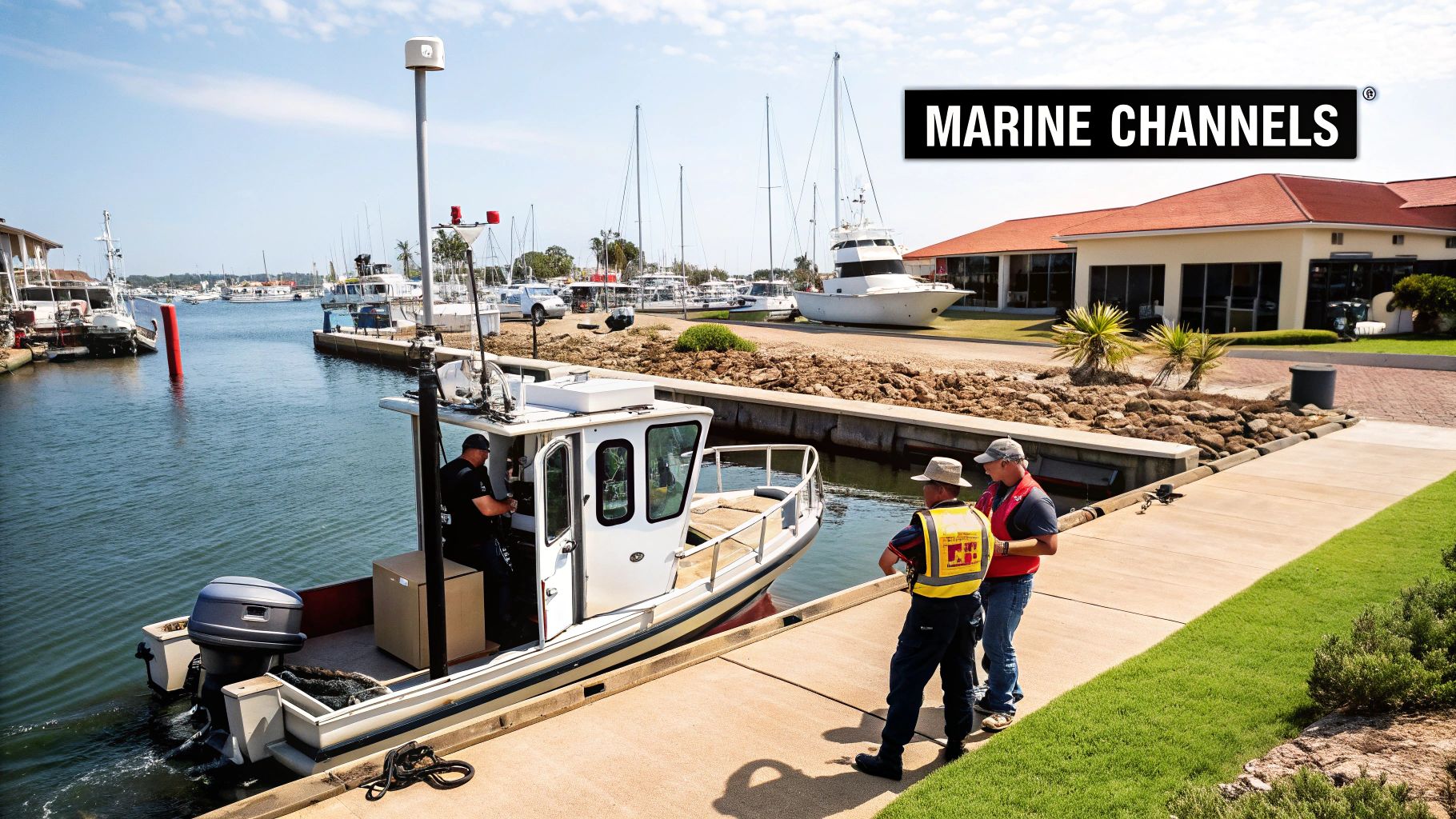
Before you even think about switching on a VHF radio, you've got to get your head around the rules. In New Zealand, the body in charge is the Radio Spectrum Management (RSM). They're the ones who allocate frequencies and set the rules for legal communication devices to ensure the airwaves stay clear for everyone, which is absolutely vital.
Think of it this way: their work prevents interference and keeps critical safety channels, especially the maritime ones, open and ready for when they're needed most. Getting to know these rules isn't just about ticking boxes; it's about making sure your equipment works properly and you're using it legally. New Zealand's organised approach to radio communication actually dates all the way back to the first licensed broadcast in 1922, a history that paved the way for the robust system we have today.
Sticking to these regulations is non-negotiable. For a deeper dive into the specifics, it's well worth checking out our complete guide to marine radio in NZ.
Maritime VHF Channels for Safety and Distress
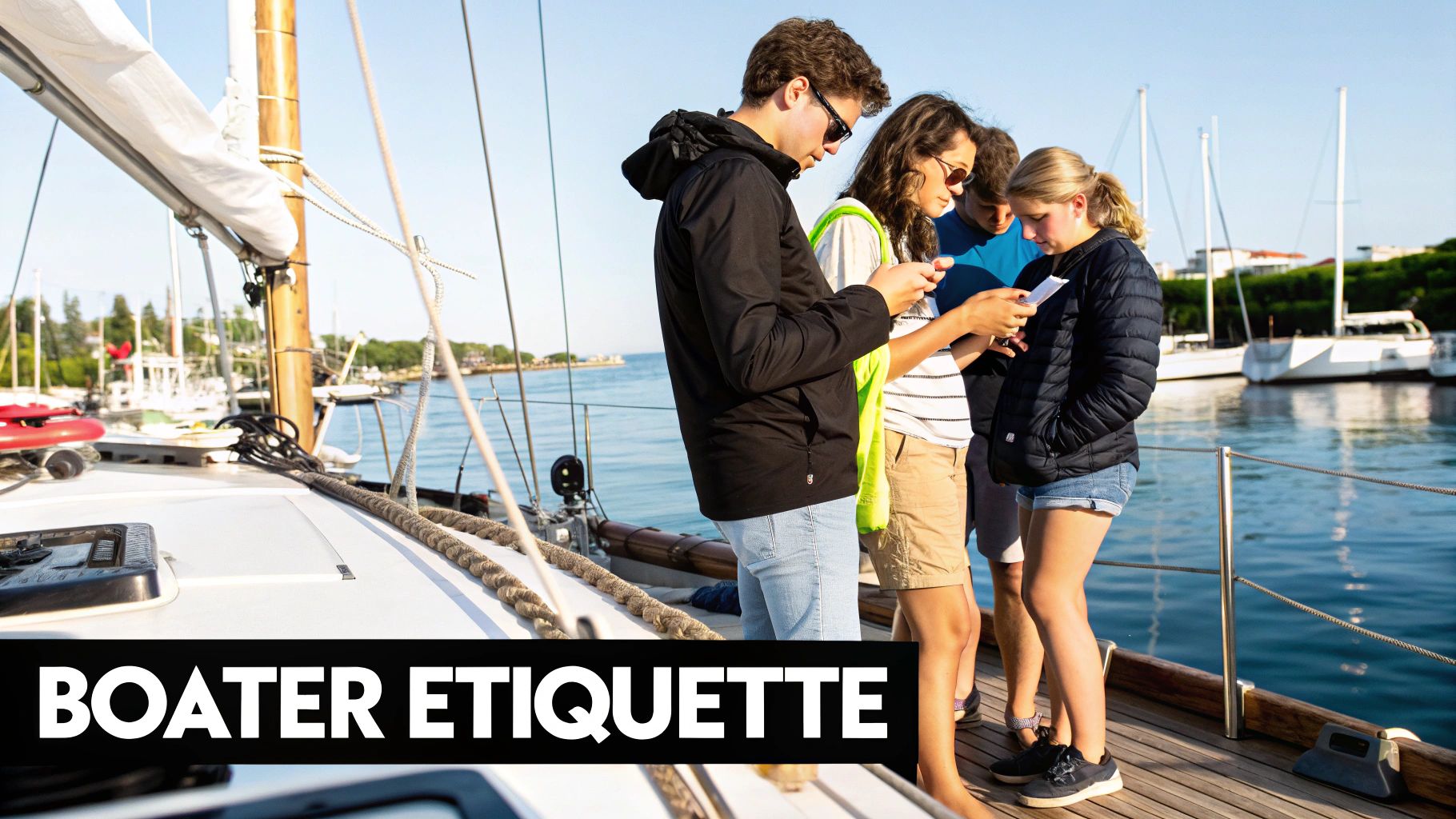
If you're out on New Zealand's coastal waters, knowing your safety and distress channels isn't just a good idea—it's a legal requirement for operating your marine radio. The single most important channel of all VHF radio channels in NZ is Channel 16. This is the international frequency reserved for distress (Mayday), urgency (Pan-Pan), and safety (Sécurité) calls.
Keeping your radio tuned to this channel is absolutely vital. Here in NZ, Maritime Radio and Coastguard work together to provide a nationwide safety network, monitoring Channel 16 24 hours a day. The official Maritime NZ VHF network consists of 28 coastal stations, plus two more on the Chatham Islands. Be aware, though, that signal blind spots can still crop up, especially near steep cliffs or deep inside fiords.
You can dive deeper into the full list of VHF marine radio frequencies in our comprehensive guide.
Of course, knowing the channels is only half the battle. A fully functional VHF radio is a non-negotiable piece of gear for any vessel. For a complete rundown of everything you should have on board, check out this an ultimate boat safety equipment checklist.
Channels for Routine Maritime and Port Communications
One of the golden rules of VHF radio is keeping Channel 16 clear for distress and calling. To make that happen, all your day-to-day on-water chatter needs to move onto the right working channels, using legally compliant equipment.
For general ship-to-ship chats between recreational boats, Channels 06 and 08 are your go-to options. Think of them as the designated space for coordinating with another vessel or having a quick yarn without clogging up the most critical frequency on the water.
Port operations are a different beast altogether, with specific channels allocated to keep harbour traffic moving safely and efficiently. If you’re navigating in major hubs like Auckland or Wellington, you'll be using channels like 12, 13, and 14 to communicate with harbour control.
You’ll also find that marinas and yacht clubs often use channels like 63 or 77 for their local operations, like allocating berths or coordinating club events. Sticking to these specific VHF radio channels in NZ isn’t just about following the rules—it’s what keeps our maritime network safe and organised for everyone.
Land-Based PRS and CB Radio Channels
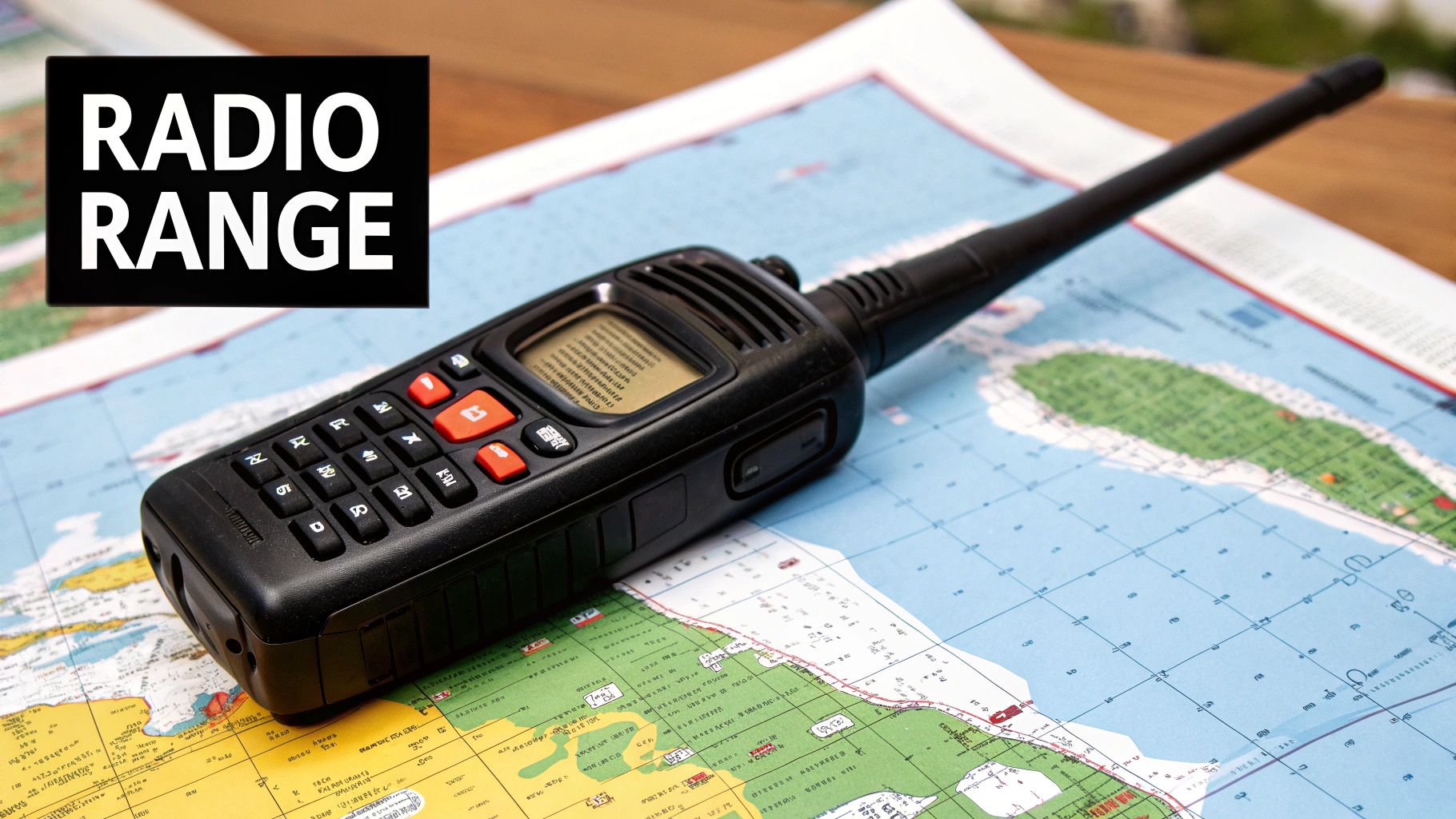
VHF radio isn't just for those out on the water. Here in New Zealand, a specific set of frequencies are designated for public use on land, known as the Personal Radio Service (PRS) and Citizen Band (CB) radio channels. These are your go-to channels for short-range comms in industries like farming, forestry, and construction, not to mention for recreational crews like 4WD enthusiasts. These solutions are commonly available from communication specialists throughout the country.
Getting your head around these land-based vhf radio channels in NZ is essential. It means you've got a reliable way to stay in touch in the backblocks where mobile reception is patchy or non-existent, without straying onto marine frequencies where you shouldn't be.
Anyone using these channels operates under a General User Radio Licence (GURL). This isn't something you apply for, but a set of rules you must follow. It covers everything from power limits and antenna types to the basic on-air etiquette needed to keep the airwaves clear for everyone.
Other VHF Frequencies You Might Encounter
While most of us are concerned with marine and land mobile channels, the VHF spectrum isn't just for boaties and truckies. New Zealand’s airwaves are carefully carved up for a few other specialised services you should be aware of.
These other users include amateur radio operators (often called 'Hams'), licensed commercial businesses running their own private radio networks, and even, historically, our old analogue television channels. Knowing they exist helps explain why you can't just pick any frequency you like—they're likely already in use by another legal communication device.
For instance, the frequencies once used for TV broadcasting were a bit of a mishmash, with channels 10 and 11 only being squeezed in during the 1980s. You can get a sense of this old allocation by looking up the history of NZ television frequencies on Wikipedia.
With this broader picture, you've got a much better handle on the entire VHF landscape. To dive deeper into the actual gear you'll be using on the water, be sure to check out our detailed guide on what to know about VHF marine radio.
Common Questions About VHF Radio Use in NZ
When you're getting to grips with VHF radio, a few questions always seem to pop up. Getting these sorted is key to making sure you're operating your gear safely and legally, whether you're out on the water or sticking to dry land.
One of the most common points of confusion is licensing. It's not a one-size-fits-all situation—some radios demand a proper qualification, while others are covered by a general licence. Knowing which camp your radio falls into is the first step to staying on the right side of the rules set by Radio Spectrum Management (RSM).
Do I Need a Licence to Use a VHF Radio in NZ?
That really depends on the type of device and where you plan to use it. If you're operating a maritime VHF radio on any kind of vessel, the answer is a hard yes. You are legally required to hold a Maritime VHF Radio Operator Certificate. This isn't just a bit of paper; it proves you know the correct legal procedures for everything from a simple radio check to a life-or-death distress call.
For land-based PRS (Personal Radio Service) radios, things are a bit different. You don't need a specific operator certificate to use one of these legally available devices. However, you are still bound by the conditions of the General User Radio Licence (GURL), which dictates things like which channels you can use and how much power you can transmit with.
What is the Range of a VHF Radio?
Because VHF is a ‘line-of-sight’ technology, its range is all about what your antenna can "see". It’s not one simple number, as several things have a major impact on how far your signal can travel:
- Antenna Height: This is the big one. A higher antenna sees further over the horizon, which can dramatically boost your range.
- Power Output: A fixed-mount radio pushing out up to 25 watts will always have more reach than a small handheld unit, which typically operates between 1 and 6 watts.
- Terrain: Anything that gets in the way will block or weaken your signal. Think hills, large buildings, and even thick bush.
As a rough guide, a handheld radio might get you 5-8km on a good day. A boat with a well-placed, tall antenna, however, could easily achieve a range of 20-30km or even more when talking to a coastal station.
Can I Use My Marine VHF Radio on Land?
Absolutely not. In New Zealand, this is strictly illegal, and for a very good reason. Maritime VHF frequencies are specifically set aside for use at sea to keep life-saving channels clear and free from interference.
Using a marine radio on land, even just for a quick chat, could potentially disrupt critical emergency communications for a vessel in distress. For any land-based use, you must use a dedicated PRS or CB radio, as they operate on completely different, legally allocated channels.
For robust and reliable communication solutions tailored to New Zealand's unique conditions, trust the experts. Mobile Systems Limited offers a complete range of sales, installation, and support services to keep you connected. Explore our leading products and custom solutions at https://mobilesystems.nz.


